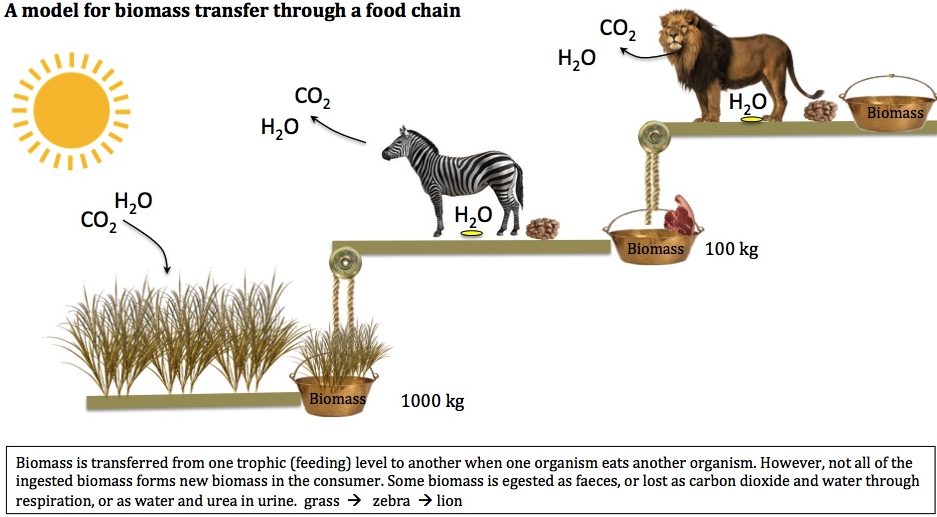Food chains teaching resources
Worksheets and lesson ideas to challenge students aged 11 to 16 to think hard about food chains and bioaccumulation (GCSE and Key Stage 3)
Overview: the sun is the ultimate source of energy for most living organisms. Plants harness the solar energy through photosynthesis and use this energy to make glucose. This glucose is then used in respiration or to make other cellular structures. This biomass is then transferred through an ecosystem when one organism eats another e.g. grass → rabbit → fox. The arrow shows the direction in which energy/biomass is transferred and all food chains begin with a producer, so called because they produce their own food. As biomass is transferred between trophic levels (trophic comes from Greek ‘to feed’) most biomass is lost (about 90%) through excretion of urine and faeces and waste gases from respiration. Only some of this biomass (about 10%) is incorporated into new tissue.
Key concept: energy from the sun is captured by plants through photosynthesis and used to make glucose which is then used in respiration or to make new cells (biomass). Some of this biomass is passed along a food chain when one organism eats another. The majority of this biomass though (~90%) is wasted at each step.
From big idea: organisms require a supply of energy and materials for which they often depend on, or compete with, other organisms
Linked knowledge: carbon cycle, photosynthesis, respiration, cell structure, energy
Misconception [scientific idea]: anthropocentric ideas e.g. there are more herbivores than carnivores because people breed them; energy adds up through a food chain e.g. a top predator has all the energy from producers and consumers [energy is actually lost through a food chain]; food that is eaten is not incorporated into body tissues but is stored separately [digested food is incorporated into new cells and is available to the next trophic level]
Teaching resources
Where to start?
Before we get stuck into food chains and food webs, it’s important that students have time to explore habitats and organisms first. Videos or setting homework to explore the animals of the Serengeti work well.
Building and understanding food chains and webs
GCSE activity and worksheet to help students understand food chains. Students work in groups to think deeply about a series of questions. For example, why don’t humans eat grass? Why are big, fierce creatures rarer than small cuddly ones? It allows students to develop a better understanding of how biomass flows through a food chain. Alternatively, use these questions as homework. (PDF)
 Biomass transfer through food chains
Biomass transfer through food chains
GCSE worksheet on biomass transfer in food chains. This is a hard activity that gets students to think deeply about the transfer of biomass between trophic levels. We casually say when teaching food chains that only 10 % of the biomass from each trophic level is transferred to the level above. What we should say is that only 10% of the biomass from each trophic level is transferred into the biomass of the trophic level above; otherwise, we risk introducing a misconception. (PDF)
Bioaccumulation
Bioaccumulation of plastics in food chains provides an excellent context to introduce bioaccumulation but also illustrates how humans impact ecosystems. The video below explores microplastics in oceans.
Going deeper
- If biomass is lost through a food chain, why are secondary consumers generally bigger than primary consumers?
- Why can a vegetarian diet support more people per tonne of producer?
- Does a food chain have to start with a living organism?
